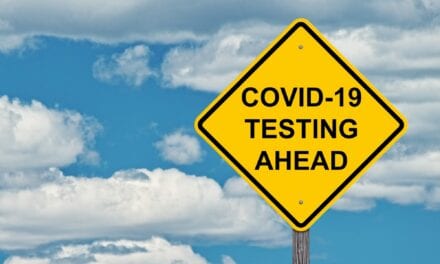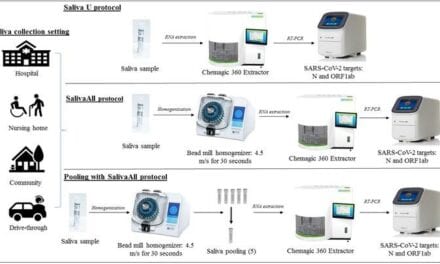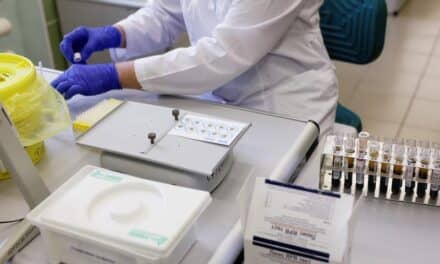Droplet digital PCR can detect covid-19 cases qPCR misses
By Monica Herrera, MD, and Carolyn Reifsnyder
As of January 4, 2021—nearly a year after the Centers for Disease Control and Prevention (CDC) and Washington state reported the first confirmed case of covid-19 in the United States—the US death toll from the disease had reached more than 351,000 people.1 Public officials can argue what caused such a high case count in this country, but one thing is certain: SARS-CoV-2 infection, like the illness it causes, is hard to detect, trace, and defeat.
One reason for this truth is that infectivity doesn’t necessarily correlate with symptomology. In many cases, patients may carry the virus well before or after they show symptoms, potentially spreading it while they themselves are apparently healthy. And, according to the CDC, as many as 40% of SARS-CoV-2 carriers don’t show any symptoms at any point during their infection.2
For those who do show symptoms, the extended incubation period (2 days to 14 days) creates a window for the virus to spread undetected.3 Further, convalescent patients who no longer display any clinical symptoms may still carry the virus and are in danger of being released from isolation prematurely.4
Together, these data show that authorities cannot rely on clinical symptoms alone to track, trace, and mitigate the spread of SARS-CoV-2 in a population. It’s critical that hospitals have access to a highly sensitive diagnostic test that can give suspected patients, physicians, and public health authorities certainty over whether someone is carrying the virus at a level that poses a threat to their community.
A community that can accurately detect SARS-CoV-2 carriers, whether or not these individuals display symptoms, can act more swiftly to quarantine infected individuals and impose targeted social distancing rules and guidelines. Unfortunately, real-time quantitative PCR (qPCR)—the current gold standard method for detecting viral load in patients—is not sensitive enough to deliver a definitive result.
Most of the SARS-CoV-2 tests being used across the world today are based on qPCR technology. However, qPCR is subject to significant variability—for two reasons. First, the results are only qualitative, not quantitative. They are interpreted through comparison to a standard curve, the generation of which is subject to error and bias. Second, the metric used to define the outcome of the test is unreliable. qPCR determines SARS-CoV-2 RNA concentration by counting the number of amplification cycles it takes for the RNA to reach a certain fluorescence intensity threshold. But amplification can be diminished by PCR inhibitors, which disrupt the count. Together, these issues reduce the sensitivity of qPCR—and these issues cause real concerns as authorities try to identify covid-19 carriers across the United States.
At the beginning of the pandemic, inconsistent qPCR results yielded mass confusion and panic. Two early patients stopped showing symptoms of covid-19 and twice tested negative using qPCR, prompting their release from a hospital in San Antonio. The CDC later determined that the patients were still contagious.5 Since then, it has been common for hospitals to deliver test results with a disclaimer about the potential inaccuracy of qPCR.
According to recent studies, the false positive rate of qPCR covid diagnostics ranges from 10% to 40%, and it has become common practice to test suspected patients repeatedly, especially if their symptoms and test results contradict.6 Some patients who initially test negative later test positive. Because of the unreliability of qPCR-based tests, the prevailing criterion for declaring someone as clear of the virus is two consecutive negative respiratory specimens collected 24 hours apart.7
All of this confusion makes it challenging to identify true covid-19 cases and use that information to implement targeted mitigation strategies. For physicians, epidemiologists, and public officials to do their work effectively, they need to be able to determine whether an individual is truly carrying SARS-CoV-2.
A More Sensitive Tool
One highly sensitive tool—droplet digital PCR (ddPCR)—may help to increase diagnostic certainty when used to complement qPCR.
Unlike qPCR, ddPCR provides an absolute count of viral titer, independent of a standard curve. It’s also less susceptible to PCR inhibitors, which makes ddPCR technology more sensitive. The technology itself has been used in the clinic to monitor nucleic acid biomarkers in cancer patients and in research labs to count viral titers in plants. When the pandemic struck, researchers soon found that ddPCR technology is ideally suited to detect and monitor SARS-CoV-2 viral titer in respiratory specimens.
In practice, ddPCR involves partitioning a sample into tens of thousands of nanoliter-sized droplets, with a separate PCR reaction taking place in each. Droplets containing the sequence of interest, such as a sequence from the SARS-CoV-2 virome, fluoresce brightly, while the droplets that don’t contain this sequence emit only weak, background florescence. By counting the number of bright, fluorescent droplets among all of the droplets, one can calculate the concentration of the virus in the sample. The strength of this method comes from how the quantitative results are used to give a more accurate qualitative diagnosis.8 Droplet digital PCR is highly sensitive, making the technology ideal for aiding the confirmation of qPCR results and for independently contributing to early detection and ongoing monitoring of the virus in patients.
Many researchers who had ddPCR platforms in their laboratories prior to the pandemic pivoted to study SARS-CoV-2 kinetics in human patients, correlating their findings with clinical symptoms. Concerned with the incidence of false positives among qPCR tests, and already familiar with the superior sensitivity of ddPCR in other applications, some researchers began to compare the two platforms’ ability to detect SARS-CoV-2 RNA in human specimens.
Researchers at Wuhan University in China investigated the sensitivity of qPCR and ddPCR for detecting the virus in suspected and convalescent patients.9 Based on the prevalence of asymptomatic carriers and negative qPCR tests in patients showing clinical symptoms at their hospital, the research team was worried that physicians who were using qPCR to detect the virus were missing a significant number of cases. At the same time, there was concern that convalescent patients were being released from the hospital before the virus had cleared, exposing the people around them to the live virus.
In their study, the researchers tested throat swabs of 63 suspected outpatients and 14 supposed convalescent patients. Each sample was simultaneously tested using qPCR and ddPCR technology with the same primers and probes. Among the 63 suspected patients, qPCR detected 21 positive cases and ddPCR detected 49. Twenty-four patients who initially tested negative with qPCR but positive with ddPCR later developed clinical symptoms of the disease. They were eventually hospitalized and tested positive using qPCR no earlier than 2 days into their hospital stay. Another seven patients whose samples yielded false positives were quarantined and finally tested positive with qPCR a week or more later.
The Wuhan researchers also performed serial dilutions to test the detection limit of qPCR and ddPCR, respectively. qPCR was able to detect quantities as low as 837.2 copies of the viral sequence per reaction, while ddPCR was able to detect as low as 1.8 copies per reaction. In a second study at Wuhan University, researchers narrowed down the parameters of ddPCR’s sensitivity in detecting the coronavirus.10 ddPCR was able to detect SARS-CoV-2 in 10−4 and 10−3 diluted patient samples, while qPCR was not.
Meanwhile, researchers at Johns Hopkins University were concerned with the potential for qPCR to produce false positive results, especially in the case of repeated testing for individual patients.8 Between March 11 and May 11, 2020, the Johns Hopkins Hospital Microbiology Laboratory ran about 500 covid-19 tests per day. Some 2,194 suspected patients were tested more than once, often yielding inconsistent or unexpected results. For example, 1,788 suspected patients who were tested repeatedly using qPCR yielded negative results every time, but when the researchers tested 198 of these negative specimens using ddPCR technology, 11 came up positive.
Research at the University of Milan further demonstrated ddPCR’s ability to detect SARS-CoV-2 in qPCR-negative nasopharyngeal swabs from covid-19 suspected patients.11 The researchers’ in-house ddPCR assay detected SARS-CoV-2 RNA in nasopharyngeal samples of 19 patients who previously tested negative using qPCR. Fifteen of these patients developed pneumonia and 14 showed signs of a severe infection.

Taken together, these data highlight ddPCR’s utility as a complement to qPCR, able to detect low viral loads in suspected or convalescent patients. With concerns about accuracy overshadowing the release of each new diagnostic, ddPCR can help labs feel confident about the quality of their results when diagnosing covid-19 cases.

A sensitive covid-19 diagnostic not only aids in detecting cases, but it also helps physicians assess whether a patient is likely to spread the virus to others. It can help guide the decision for patients to remain in quarantine before they spread the virus to others. It can also help government authorities keep better track of SARS-CoV-2 carriers, potentially enabling more specific shutdown orders and resource distribution to the areas that need the most help. In all, in combination with therapeutics and vaccines, ddPCR technology may help mitigate the spread of the virus.
To read more about the use of ddPCR to monitor covid-19 in larger population, read Testing for SARS-CoV-2 in Wastewater.
Monica Herrera, MD, is program head for human genetics and infectious disease in the Digital Biology Group at Bio-Rad Laboratories.
Carolyn Reifsnyder is director of global product marketing in the Digital Biology Group at Bio-Rad Laboratories.
Featured image: A technician uses Bio-Rad’s QX200 Droplet Digital PCR System.
References
1. New York Times. Covid in the U.S.: Latest Map and Case Count. Accessed January 4, 2021. Available at: https://www.nytimes.com/interactive/2020/us/coronavirus-us-cases.html.
2. Centers for Disease Control and Prevention. COVID-19 Pandemic Planning Scenarios. Accessed September 25, 2020. Available at: https://www.cdc.gov/coronavirus/2019-ncov/hcp/planning-scenarios.html.
3. Centers for Disease Control and Prevention. Clinical Questions about COVID-19: Questions and Answers. Accessed September 25, 2020. Available at: https://www.cdc.gov/coronavirus/2019-ncov/hcp/faq.html.
4. Ling Y, Xu S-B, Lin Y-X, et al. Persistence and clearance of viral RNA in 2019 novel coronavirus disease rehabilitation patients. Chin Med J. 2020;133(9):1039-1043. doi: 10.1097/CM9.0000000000000774.
5. Caruba L. Two coronavirus patients released from a San Antonio hospital accompanied to airport. My San Antonio. March 6, 2020. Available at: https://www.mysanantonio.com/news/local/article/CDC-releases-two-coronavirus-patients-from-San-15111294.php.
6. Weissleder R, Lee H, Ko J, Pittet MJ. COVID-19 diagnostics in context. Sci Transl Med. 2020;12(546):eabc1931. doi: 10.1126/scitranslmed.abc1931.
7. Centers for Disease Control and Prevention. Discontinuation of Transmission-Based Precautions and Disposition of Patients with COVID-19 in Healthcare Settings (Interim Guidance). Accessed September 25, 2020. Available at: https://www.cdc.gov/coronavirus/2019-ncov/hcp/disposition-hospitalized-patients.html.
8. Gniazdowski V, Morris CP, Wohl S, et al. Repeat covid-19 molecular testing: correlation with recovery of infectious virus, molecular assay cycle thresholds, and analytical sensitivity. MedRxiv. Published August 6, 2020. doi: 10.1101/2020.08.05.20168963.
9. Suo T, Liu X, Feng J, et al. ddPCR: a more accurate tool for SARS-CoV-2 detection in low viral load specimens.Emerg Microbes Infect. 2020;9(1):1259-1268. doi: 10.1080/22221751.2020.1772678.
10. Liu X, Feng J, Zhang Q, et al. Analytical comparisons of SARS-COV-2 detection by qRT-PCR and ddPCR with multiple primer/probe sets. Emerg Microbes Infect. 2020;9(1):1175-1179. doi: 10.1080/22221751.2020.1772679.
11. Alteri C, Cento V, Antonello M, et al. Detection and quantification of SARS-CoV-2 by droplet digital PCR in real-time PCR negative nasopharyngeal swabs from suspected COVID-19 patients. PLOS ONE. 2020;15(9):e0236311. doi: 10.1371/journal.pone.0236311.

Premium Article Access
Thank you for your interest in this content!
To view the article and continue reading, please fill out the short form.





